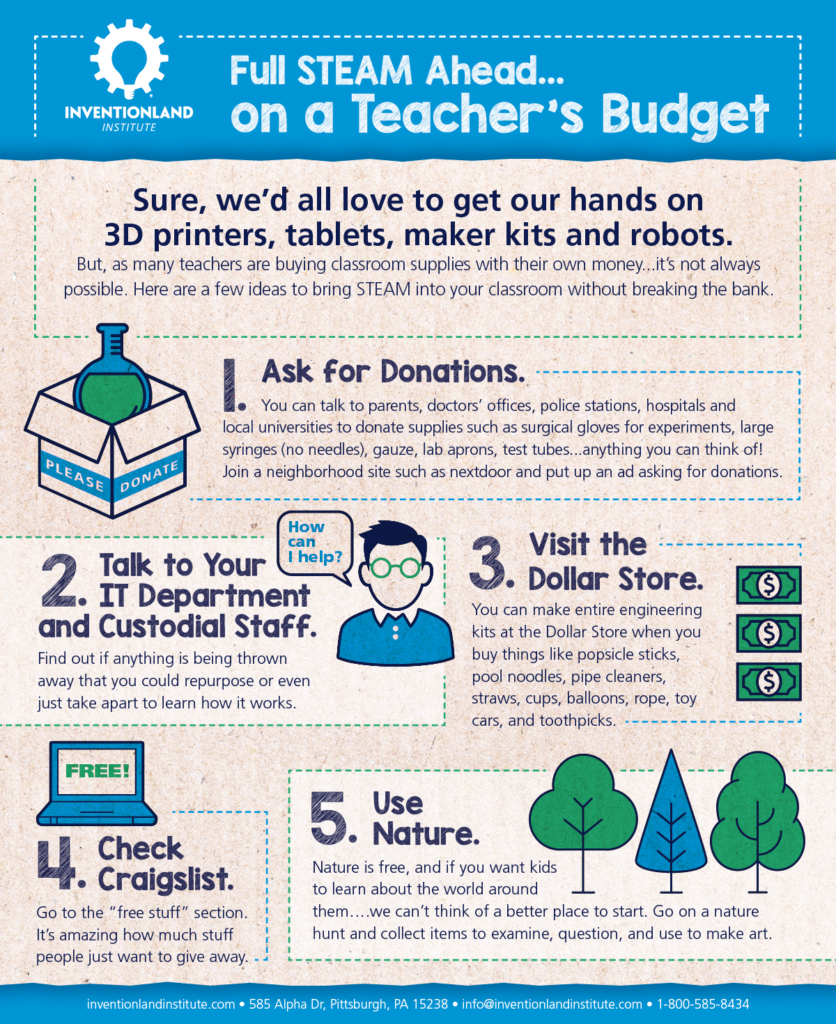Six Tips to Overcoming STEAM Fear
3D printers, model making, and injection molding…oh my! If you’re a teacher considering adding a little STEAM (Science, Technology, Engineering, Art and Math) to your classroom, but steam literally comes out of your ears just thinking about learning how to use the technology involved…don’t worry! Here are some do’s and don’ts to help you make STEAM integration a little less intimidating.
DO add STEAM to any class
You may not see the correlation immediately, but it’s there. If your goal as a teacher is to help students apply what they’re learning to the world around them, then a STEAM-integrated lesson plan is a natural fit. If, for example, you’re an English teacher working on the sometimes-dreaded Shakespeare unit, let your students engineer a scaled version of the Globe Theatre or research how modern technology may have saved the doomed lovers’ lives if this happened today.

DON’T only consider high-tech advancements as a STEAM integration
Contrary to popular belief, STEAM isn’t just about advanced technology. It’s about integrating the arts and sciences into a lesson in a way that encourages creative and critical thinking. There are many ways you can do that that don’t involve rocket science (although if you’re comfortable teaching rocket science, go for it!). Whether building a propeller-powered car or making their own Mondrian or engineering innovative packaging, you don’t need the most advanced technology to teach STEAM-based classes.
DON’T use every letter of the STEAM acronym every time you integrate
Go ahead and breathe a sigh of relief…a STEAM lesson plan doesn’t have to be a “STEAM” lesson plan. It can be a “SAM” lesson or a “ME” lesson or even an “A” lesson. It’s okay (and even encouraged) to only focus on a few parts of the acronym at a time. Your goal, after all, is to have an overall classroom environment that regularly uses these areas over the course of the school year…not a 45-minute class period that crams it all in every once in a while.

DO look for STEAM supplies in unusual places
Making your classroom a STEAM classroom with top-of-the-line equipment might not be possible on a teacher’s salary. You can, however, ask for donations using sites like Craigslist or NextDoor (just always pick up in a public, well-lit location). Contact local universities or hospitals to see if they would donate anything. Send a letter home to parents…they may work in for a STEAM company that donates supplies to schools. The options are endless. Check out the graphic below for more ideas.

DO attend continuing ed workshops
Keep your eyes peeled for innovative workshops you can attend. You need them to keep your license up-to-date, and they’re a great way to let you learn first-hand about STEAM innovations you can bring to your classroom. Inventionland® Education offers Day of Innovation workshops where teachers can learn hands-on how to add STEAM lessons to their units. Keep an eye on our website for an up-to-date calendar.
DO ask for help
Team teaching is a great way to integrate STEAM into your classroom. If you teach a specific subject, talk to other teachers to see what units they are introducing in the semester and see if you can work together to create a project. Find the overlap or create one yourself. A math lesson that transfers into a history lesson (or science lesson or art lesson…) creates memorable learning moments and gives students a chance to see how content really does apply to their everyday lives.
If you are an elementary teacher, talk to other teachers in your grade level about collaborating on a grade-wide project. You can have a penny boat challenge that doubles as a fundraiser for your school. You can make models of famous landmarks and host an “Around the World” night. Bringing students together for a large product creates a sense of community, encourages teamwork, and gives students a chance to show off their work on a larger scale.

And remember…you don’t teach because you know everything there is to know about your content area (although that may be true). You teach because you are passionate about your job. Even if you don’t know how the latest and greatest technology works, you want to help students. Don’t be afraid to learn new technology right alongside them and don’t be afraid to let them know you don’t know everything. It’s your passion for teaching and learning that will help you successfully teach any part of your STEAM curriculum.